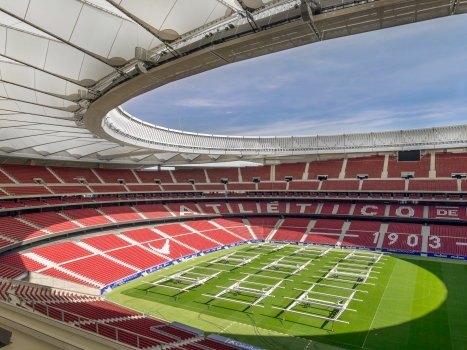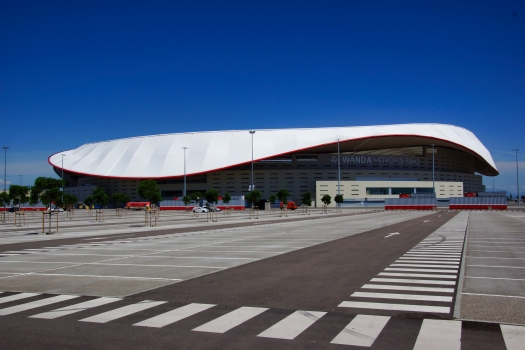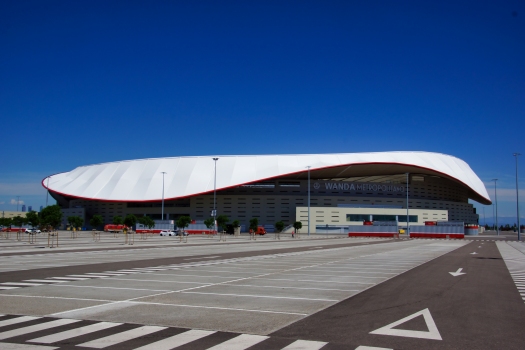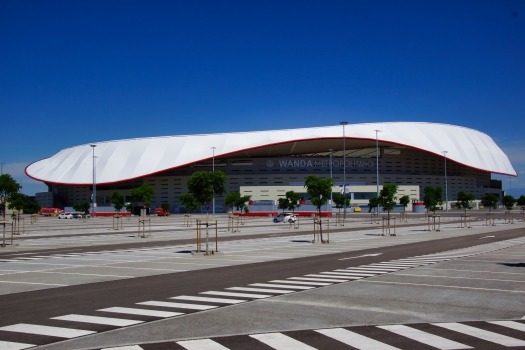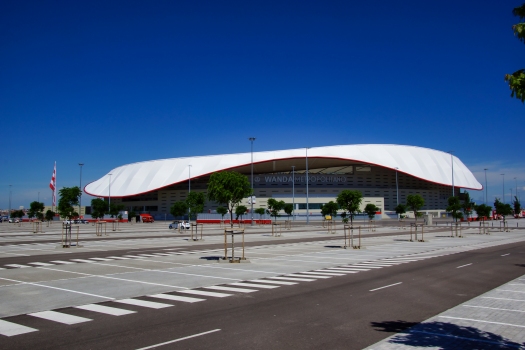General Information
| Name in local language: | Estadio Wanda Metropolitano |
|---|---|
| Completion: | 2017 |
| Status: | in use |
Project Type
| Function / usage: |
Stadium / Arena |
|---|---|
| Structure: |
roof: Membrane structure |
| Material: |
roof: Steel structure |
| Structure: |
roof: Cable-supported structure |
| Material: |
grand stands: Reinforced concrete structure |
Location
| Location: |
Madrid, Madrid, Spain |
|---|---|
| Address: | Plaza de Grecia |
| Coordinates: | 40° 26' 10.26" N 3° 35' 58.63" W |
Technical Information
Dimensions
| width | 248 m | |
| length | 286 m | |
| seats | 67 703 | |
| roof | membrane covered area | 46 000 m² |
Cost
| cost of construction | Euro 240 000 000 |
Materials
| tension ring |
steel
|
|---|---|
| grand stands |
reinforced concrete
|
| compression ring |
steel
|
Notes
The project consisted of converting the existing stadium should to a completely covered soccer arena for the club of Atlético Madrid. This was achieved by completing the concrete tiers and by adding a spoked wheel roof. In addition to that a large canopy was required to cover the entire main grandstand and parts of the forecourt. A novelty is the use of two compression and two tension rings for the roof structure. The space in between is filled by radial cables and a zig-zag shaped membrane. A third chord completes the two compression ring to a three-chord truss that spans almost columnfree over the existing grand stand and that also supports the canopy structure. The canopy consists of radial trusses that are covered by membranes from above and below. Steel construction, membrane construction and the erection of the complete roof were realized in a short construction period of only one year.
Excerpt from Wikipedia
Metropolitano Stadium (Spanish: Estadio Metropolitano), also referred to as Wanda Metropolitano for sponsorship reasons, is a stadium in Madrid, Spain. It has been the home stadium of Atlético Madrid since the 2017–18 season. It is located in Rosas neighbourhood in the San Blas-Canillejas district.
The stadium was built as part of Madrid's unsuccessful bid to host the 1997 World Athletics Championships, and was opened on 6 September 1994 by the Community of Madrid. It was closed in 2004 due to the city's bid for the 2016 Olympics and in 2013 it was passed into the possession of Atlético Madrid. The stadium was renovated and the new facility was reopened to the public on 16 September 2017, when Atlético Madrid faced Málaga CF in La Liga. The stadium had a capacity of 20,000 spectators upon its closure and re-opened with a seating capacity of 68,456 after renovation. The stadium is home to Atlético Madrid's first team matches. Atlético Madrid offered Wanda Metropolitano as a permanent venue for the finals of the Spanish Copa del Rey matches. The stadium hosted the 2019 UEFA Champions League Final on 1 June 2019.
Name
The stadium was formerly known as Estadio de la Comunidad de Madrid (Madrid Community Stadium), Estadio Olímpico de Madrid (Madrid Olympic Stadium), and more commonly by its nickname Estadio de La Peineta (The Comb Stadium). Naming rights were acquired by the Wanda Group, a Chinese real estate company. Due to UEFA sponsorship regulations the stadium is known as Estadio Metropolitano in UEFA marketing materials.
History
During the early 1990s the Sports Council of the Community of Madrid promoted the city's bid to host the World Athletics Championships in 1997, and preparations began for an Olympic stadium in the east of Madrid, next to the M-40 motorway. The site was expected to be heavily urbanized.
Construction of the new stadium began in 1990 and was based on a design proposed by Cruz y Ortiz. It was completed in 1993, and the inauguration took place in September 1994. The single side tier oval shaped stadium with a capacity 20,000 seats became known as La Peineta (the comb) because of its similarity with the traditional Spanish hair comb.
The 1997 World Championships in Athletics were eventually awarded to Athens, and La Peineta was used for minor sports and cultural events during the first decade of its existence.
New stadium
In 2004, the stadium was closed for a future project upon the Madrid bid for the 2016 Summer Olympics. Following the defeat of Madrid's bid in 2009, many proposals were made for the future use of the stadium. Finally, on 11 September 2013, Atlético Madrid announced their plans to build a stadium on the location of La Peineta. Thus ownership was officially transferred to the club.
The new stadium was scheduled to replace Vicente Calderón Stadium as Atletico's home beginning with the 2017–18 season. On 9 December 2016, the club announced that the renovated stadium's official name would be Wanda Metropolitano – Wanda for sponsorship reasons and Metropolitano after the 1923–1966 arena which hosted Atlético's matches before Vicente Calderón. As of 15 April 2017, around 48,500 season tickets had been reserved by the club fans.
On 17 September 2017, the Wanda Metropolitano's inaugural event was a 2017–18 La Liga match between Atlético Madrid and Málaga CF. King Felipe VI of Spain attended the match. Atlético's Antoine Griezmann would go on to score the first goal at the new stadium, in which the match ended in a 1–0 win for Atlético. On 27 September 2017, the Wanda Metropolitano hosted its first UEFA Champions League game. Chelsea beat Atlético Madrid 2–1, becoming the first English club to defeat them at home in any European club competition, and the first visiting team to win at the new stadium.
It accommodates 68,000 spectators, with all spectator seats covered by a new roof including 7,000 VIP, 79 VIP suites known as Neptuno Premium. 4,000 car parking spaces is available; 1,000 inside the stadium building and 3,000 outside the building.
Text imported from Wikipedia article "Metropolitano Stadium" and modified on May 28, 2020 according to the CC-BY-SA 4.0 International license.
Participants
- MC2 Estudio de Ingeniería, S.L. (concrete)
- schlaich bergermann partner (roof)

Relevant Web Sites
Relevant Publications
- (1995): Estructura del Estadio de Atletismo de la Comunidad de Madrid. In: Hormigón y acero, v. 46, n. 196 (2nd Quarter 1995), pp. 91-95.
- About this
data sheet - Structure-ID
20075136 - Published on:
25/04/2018 - Last updated on:
13/08/2022

